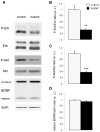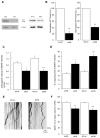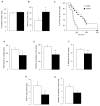Huntingtin acts non cell-autonomously on hippocampal neurogenesis and controls anxiety-related behaviors in adult mouse
- PMID: 24019939
- PMCID: PMC3760801
- DOI: 10.1371/journal.pone.0073902
Huntingtin acts non cell-autonomously on hippocampal neurogenesis and controls anxiety-related behaviors in adult mouse
Abstract
Huntington's disease (HD) is a fatal neurodegenerative disease, characterized by motor defects and psychiatric symptoms, including mood disorders such as anxiety and depression. HD is caused by an abnormal polyglutamine (polyQ) expansion in the huntingtin (HTT) protein. The development and analysis of various mouse models that express pathogenic polyQ-HTT revealed a link between mutant HTT and the development of anxio-depressive behaviors and various hippocampal neurogenesis defects. However, it is unclear whether such phenotype is linked to alteration of HTT wild-type function in adults. Here, we report the analysis of a new mouse model in which HTT is inducibly deleted from adult mature cortical and hippocampal neurons using the CreER(T2)/Lox system. These mice present defects in both the survival and the dendritic arborization of hippocampal newborn neurons. Our data suggest that these non-cell autonomous effects are linked to defects in both BDNF transport and release upon HTT silencing in hippocampal neurons, and in BDNF/TrkB signaling. The controlled deletion of HTT also had anxiogenic-like effects. Our results implicate endogenous wild-type HTT in adult hippocampal neurogenesis and in the control of mood disorders.
Conflict of interest statement
Figures






Similar articles
-
Mood disorders in Huntington's disease: from behavior to cellular and molecular mechanisms.Front Behav Neurosci. 2014 Apr 23;8:135. doi: 10.3389/fnbeh.2014.00135. eCollection 2014. Front Behav Neurosci. 2014. PMID: 24795586 Free PMC article. Review.
-
Huntingtin mediates anxiety/depression-related behaviors and hippocampal neurogenesis.J Neurosci. 2013 May 15;33(20):8608-20. doi: 10.1523/JNEUROSCI.5110-12.2013. J Neurosci. 2013. PMID: 23678106 Free PMC article.
-
Mutant Huntingtin alters retrograde transport of TrkB receptors in striatal dendrites.J Neurosci. 2013 Apr 10;33(15):6298-309. doi: 10.1523/JNEUROSCI.2033-12.2013. J Neurosci. 2013. PMID: 23575829 Free PMC article.
-
Elucidating a normal function of huntingtin by functional and microarray analysis of huntingtin-null mouse embryonic fibroblasts.BMC Neurosci. 2008 Apr 15;9:38. doi: 10.1186/1471-2202-9-38. BMC Neurosci. 2008. PMID: 18412970 Free PMC article.
-
Wild-type huntingtin plays a role in brain development and neuronal survival.Mol Neurobiol. 2003 Dec;28(3):259-76. doi: 10.1385/MN:28:3:259. Mol Neurobiol. 2003. PMID: 14709789 Review.
Cited by
-
A pathogenic proteolysis-resistant huntingtin isoform induced by an antisense oligonucleotide maintains huntingtin function.JCI Insight. 2022 Sep 8;7(17):e154108. doi: 10.1172/jci.insight.154108. JCI Insight. 2022. PMID: 35943803 Free PMC article.
-
Is Huntingtin Dispensable in the Adult Brain?J Huntingtons Dis. 2017;6(1):1-17. doi: 10.3233/JHD-170235. J Huntingtons Dis. 2017. PMID: 28339401 Free PMC article. Review.
-
Huntingtin and the Synapse.Front Cell Neurosci. 2021 Jun 15;15:689332. doi: 10.3389/fncel.2021.689332. eCollection 2021. Front Cell Neurosci. 2021. PMID: 34211373 Free PMC article. Review.
-
Mood disorders in Huntington's disease: from behavior to cellular and molecular mechanisms.Front Behav Neurosci. 2014 Apr 23;8:135. doi: 10.3389/fnbeh.2014.00135. eCollection 2014. Front Behav Neurosci. 2014. PMID: 24795586 Free PMC article. Review.
-
Increasing brain palmitoylation rescues behavior and neuropathology in Huntington disease mice.Sci Adv. 2021 Mar 31;7(14):eabb0799. doi: 10.1126/sciadv.abb0799. Print 2021 Mar. Sci Adv. 2021. PMID: 33789888 Free PMC article.
References
-
- Duff K, Paulsen JS, Beglinger LJ, Langbehn DR, Stout JC (2007) Psychiatric Symptoms in Huntington’s Disease before Diagnosis: The Predict-HD Study. Biol Psychiatry 62: 1341–1346. doi:10.1016/j.biopsych.2006.11.034. PubMed: 17481592. - DOI - PubMed
-
- Julien CL, Thompson JC, Wild S, Yardumian P, Snowden JS et al. (2007) Psychiatric disorders in preclinical Huntington’s disease. J Neurol Neurosurg, Psychiatry 78: 939–943. doi:10.1136/jnnp.2006.103309. - DOI - PMC - PubMed
-
- Gil-Mohapel J, Simpson JM, Ghilan M, Christie BR (2011) Neurogenesis in Huntington’s disease: Can studying adult neurogenesis lead to the development of new therapeutic strategies? Brain Res 1406: 84-105. doi:10.1016/j.brainres.2011.06.040. PubMed: 21742312. - DOI - PubMed
-
- Menalled L, El-khodor BF, Patry M, Orenstein SJ, Zahasky B et al. (2009) Systematic behavioral evaluation of HD transgenic and KI mouse models. Neurobiol Dis 35: 319–336. doi:10.1016/j.nbd.2009.05.007. PubMed: 19464370. - DOI - PMC - PubMed
-
- Orvoen S, Pla P, Gardier AM, Saudou F, David DJ (2012) Huntington’s disease knock-in male mice show specific anxiety-like behaviour and altered neuronal maturation. Neurosci Lett 507: 127–132. doi:10.1016/j.neulet.2011.11.063. PubMed: 22178857. - DOI - PubMed
Publication types
MeSH terms
Substances
LinkOut - more resources
Full Text Sources
Other Literature Sources
Medical
Molecular Biology Databases

